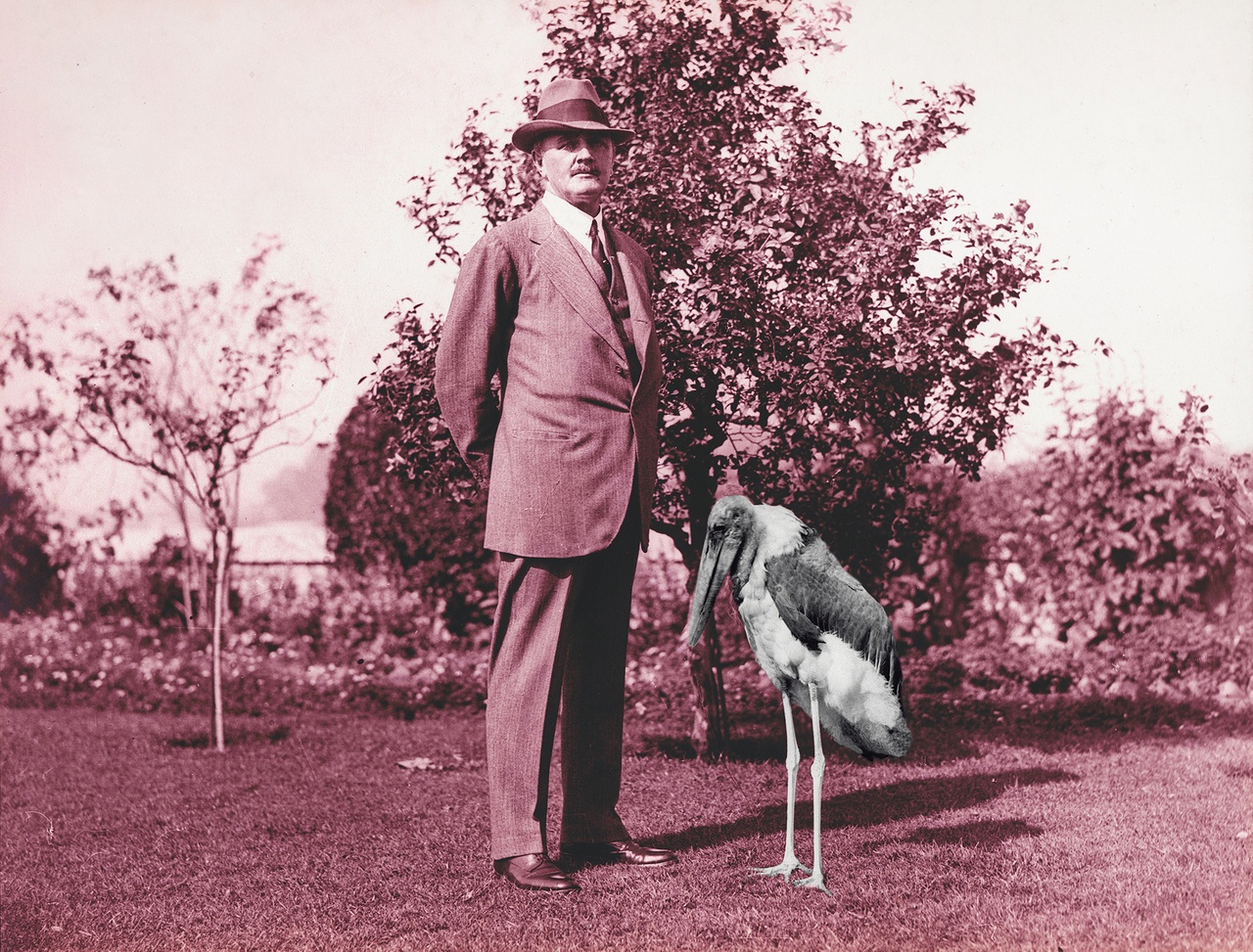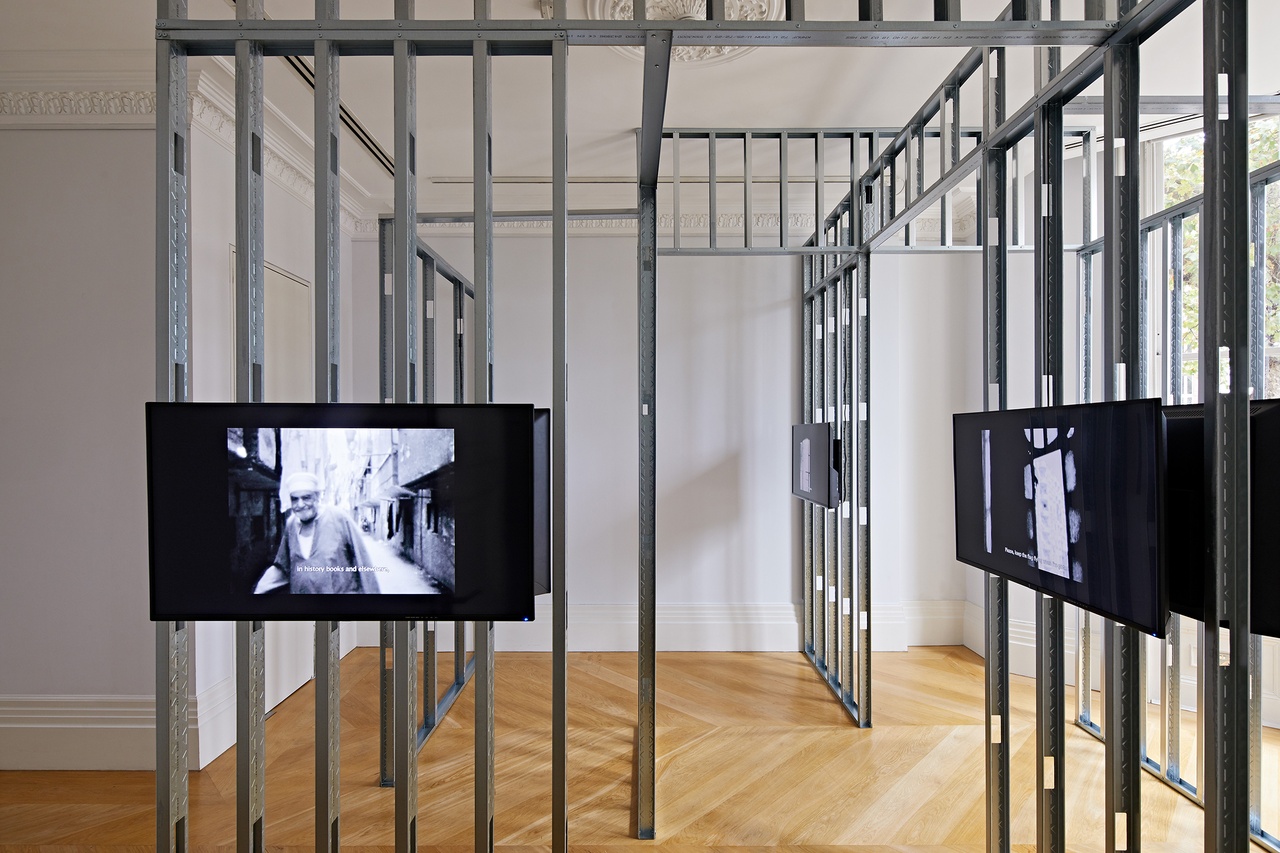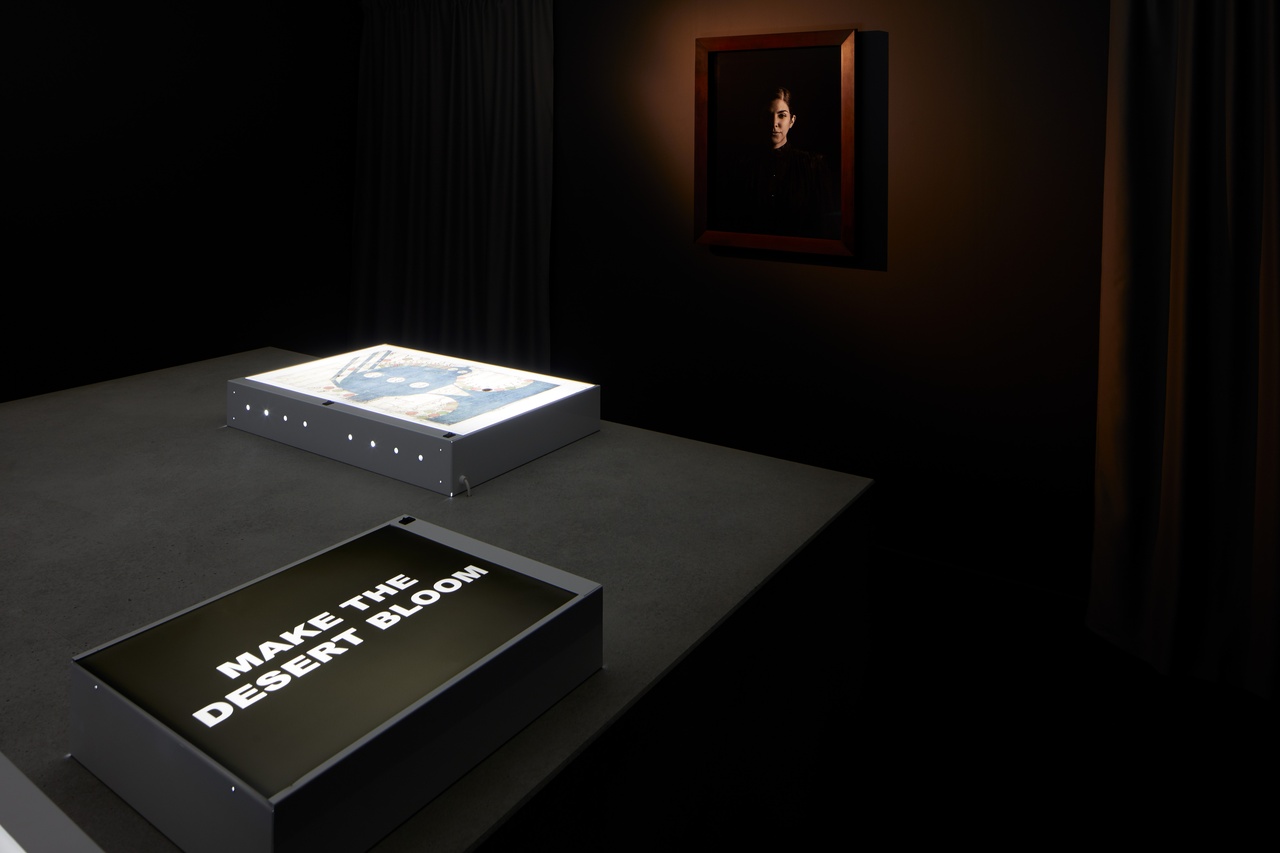I SPY WITH MY LITTLE EYE Maximiliane Leuschner on Heba Y. Amin at the Mosaic Rooms, London

Heba Y. Amin, “The General’s Stork I,” 2020
Heba Y. Amin’s poetic performative installations are poignant political commentaries in disguise. Born in 1980 in Cairo, the artist addresses the geopolitical context of Egypt and the Middle East in her works. Having lived abroad since the age of 18, first in the United States and now in Berlin, she often looks through the dual lens of insider and outsider. Amin’s artistic practice takes investigative journalism as a starting point. Her works originate in real stories, taken from news outlets and historical archives, though they are also fleeting snapshots in time: each exhibition displays different iterations of the artist’s ongoing research, in which she sensitively treats questions of colonialism and democracy, surveillance and censorship.
Amin’s “When I see the future, I close my eyes,” at The Mosaic Rooms, is her institutional debut in the United Kingdom. Set in a Georgian townhouse in Earl’s Court, the venue and cultural arm of the A. M. Qattan Foundation is one of London’s mainstays for contemporary culture from the Middle East. The exhibition elegantly explores the British rule in Egypt and follows political unrest through the lens of three research-based works: Operation Sunken Sea (2018–ongoing), The General’s Stork (2016–ongoing), and Project Speak2Tweet (2011–ongoing).
The exhibition spans three galleries on two floors with no clearly intended route. Operation Sunken Sea has been aptly placed in the basement gallery, and it simulates a darkened and stuffy conference room. Under the guise of a fictitious Arab-African woman world leader, the artist reflects on colonialist narratives, leadership megalomania, and political symbols. Continuing the ideas of Jules Verne and Herman Sörgel, Amin proposes draining the Mediterranean Sea to solve the migration crisis and end terrorism. She dishes her satirical visions like dinner plates on the table, alongside newspaper cuts and cartographies. Suddenly, the colonialist narratives coalesce into climate-altering marketing slogans: from “drain the swamp” to “canal to paradise” to “make the desert bloom.” Together with an embassy-style flag display outside of the gallery, two photographic portraits – one historical, the other framed and stately – and a 19-minute video address alongside other historical and current world leaders, Amin’s transformation seems almost complete.

“Heba Y. Amin: When I see the future, I close my eyes,” The Mosaic Rooms, 2020, installation view
Upstairs, a patio-facing gallery on the ground floor blends together two works, The General’s Stork and As Birds Flying (Kama Tohalleq al Teyour, 2016), bridging the gap between the British rule in the Middle East and Egypt today. For this genre-defying installation of photographs, films, and a publication, Amin took a catchy news story about a spying stork as the starting point for her research. In 2013, the Egyptian police in Qena detained a migrating stork that had a tracking device around its neck on charges of spying. Hungarian scientists had fitted the device to research the bird’s wintering behavior. The stork was later freed into a nature reserve with the help of a conservation agency – before it fell prey to local children from Aswan, who hunted and ate the stork shortly afterwards.
In The General’s Stork, floral stucco niches with Corinthian columns frame doctored historical photographs of Lord Edmund Allenby, the British High Commissioner of Egypt and Sudan, with his pet marabou stork. Allenby, whose name translates as “prophet” in Arabic, fulfilled a biblical prophecy when he led the capture of Jerusalem from the Ottoman Empire in 1917; part of this action was to send planes over the city, ordering those in power to surrender. Amin has undermined the black-and-white photographs’ authenticity by cutting and re-coloring details in pink. Their presentation within the ornately decorated niches appears stately and emphasizes the colonial past in Egypt. The surrounding pink walls show unframed prints from the G. Eric and Edith Matson Photograph Collection, shining a rose-tinted light on turn-of-the-century Palestine and its paradisical flora. The photographers belonged to the American Colony in Jerusalem, a late 19th- and early 20th-century Christian utopian society that was drawn to the region for its religious heritage. Their portrayals of the biblical land were often devoid of human life, imbuing their photographs with a religious/colonial gaze by neglecting the presence of the region’s inhabitants. Many governments (specifically the British) bought these negatives for colonial warfare tactics or similarly exploitative purposes. For “When I see the future, I close my eyes,” Amin has chosen dreamy photographs of petals and bushes and has juxtaposed these with the first aerial records of Palestine, from the early 20th century, when the bird’s-eye view became a reconnaissance tool for the topographical quartering of the Middle East. These aerial records have been reproduced in the project-specific publication, The General’s Stork, edited by the exhibition’s curator, Anthony Downey, and which also doubles as the official exhibition catalogue. [1]
The bird’s-eye view is also a curatorial detail in the exhibition: a tilted screen showing As Birds Flying has been placed on the floor at the center of the gallery. The film is a direct response to the spying stork incident and pairs drone footage of migrating storks in the Israeli wetlands with reworked dialogue and music sequences from the Egyptian comedy-thriller Toyour El-Zalam (Birds of Darkness, 1995). Toyour El-Zalam unravels political corruption and religious radicalism in the electoral system in Egypt, whereas Amin’s film As Birds Flying offers a dreamy antidote: like the surrounding photographs from the Matson Photograph Collection, the film is devoid of human traces. The seductive music, the drone footage, and the poetic yet poignant dialogue of a couple speaking in Egyptian dialect, subtitled in English, oscillate between sexual innuendo and political rhetoric. As Birds Flying’s soothing sounds and imagery appear to almost remedy the political paranoia of the sensational news story, leaving the visitor mesmerized.

“Heba Y. Amin: When I see the future, I close my eyes,” The Mosaic Rooms, 2020, installation view
As visitors step into the street-facing gallery on the ground floor, they come face-to-face with a completely different soundscape of riotous revolts and emotional personal messages recorded during the Egyptian revolution of 2011. The multichannel installation/archive Project Speak2Tweet (2011–ongoing), currently consisting of five films, pays homage to “speak2tweet,” a messaging service made by programmer Abdelkarim Mardini, set up in the wake of the internet shutdown in Egypt between January 27 and February 2, 2011. The platform went live within a day of the shutdown after it was discovered that landlines were not affected. Egyptians at home and abroad could dial a phone number and record personal voice messages, which were then posted to Twitter via a link. The platform went viral within hours, and phone numbers were shared widely via group texts, on TV broadcasts, and even on a lamppost on Tahrir Square. At the time, Amin was already based in Berlin and learned of the service via text. Moved by the heartfelt and expressive messages, Amin got in touch with Mardini, who shared the voice files with her after the platform was taken down. Her resulting archive of films ranges from a poem to an allegiance to the Egyptian flag and love letters to the country. Each film contains black-and-white footage of disused buildings in Cairo, which the artist has taken since the early 2000s, each layered with one unedited voice file. That Amin’s generation of Egyptians mostly refrains from expressing political opinions publicly makes Project Speak2Tweet even more poignant. Not only does she speak up, she also visually and vocally pairs the disused sites of political corruption with the emotional revolutionary spirit present at the demise of the same system.
In “When I see the future, I close my eyes,” The Mosaic Rooms’ narrow galleries allow the work to be presented anew: the colonial-inflected narrative of the exhibition delicately re-positions Project Speak2Tweet in the context of colonial-induced political unrest and corruption, which often follow a dissolving colonial rule for many years. The five films play synchronized and on a loop on eight small monitors attached to vertical metal rods at eye level and mirror the aesthetic of prison bars. The uneven distribution of monitors allows three films to play simultaneously. Their cacophony evokes claustrophobic feelings of unease and restraint, though the daylight shining through the sash windows almost softens the reception of the work. This display in London is in stark contrast to previous presentations in Berlin and Hamburg, where Amin showed the work on larger screens in huge, darkened galleries mirroring the concrete buildings of a cityscape.
For the exhibition, Amin and Downey, the artist and the curator, have embraced the digital format with a comprehensive six-month-long program of a virtual artist tour, talks, interviews, and book launches. This digital chime is also present in the exhibition’s title, “When I see the future, I close my eyes,” which borrows a line from the 1984 hit Excellent Birds that Laurie Anderson and Peter Gabriel composed and performed as part of Nam June Paik’s first-ever worldwide broadcast Good Morning, Mr. Orwell (1984).
“When I see the future, I close my eyes” is Amin’s most ambitious solo show to date, investigating colonial rule and autocratic regimes, riotous revolutions, and spying storks. And while the exhibition lends itself to a colonial- and British-centered reading at times, this is more a consequence of Amin’s intelligent and chameleonlike artistic practice, and not necessarily representative of her œuvre. Instead, her works are assertive ambassadors of Egypt and the Middle East, offering a proposition for whoever chooses to look.
“Heba Y. Amin: When I see the future, I close my eyes,” The Mosaic Rooms, London, October 1, 2020–March 28, 2021. The exhibition will reopen when UK restrictions allow. Extension dates for the exhibition are still to be announced.
Maximiliane Leuschner is an art historian and writer based in London.
Image credit: 1. Courtesy of the artist; 2. Photo Andy Stagg, courtesy of The Mosaic Rooms; 3. Photo Andy Stagg, courtesy of the artist
Note
| [1] | Anthony Downey, The General’s Stork (Berlin: Sternberg Press, 2020). |
